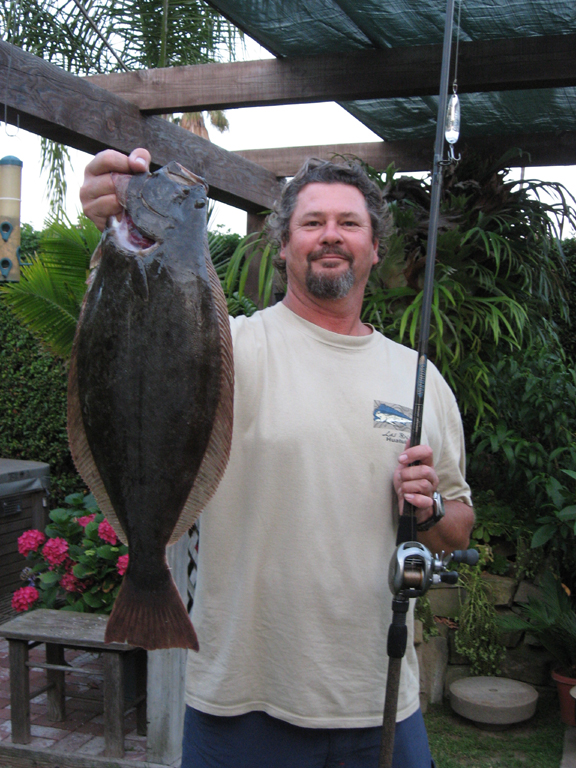
By Bill Varney Jr.
 Grunion runs are blasting the beach and there’s no time like the present to get down there and hunt for halibut. Spring brings both the spawning time and massive balls of grunion together to drive flatties crazy.
Grunion runs are blasting the beach and there’s no time like the present to get down there and hunt for halibut. Spring brings both the spawning time and massive balls of grunion together to drive flatties crazy.
Now’s the time to get your equipment together to have a least a fair chance of catching a keeper. Here are my recommendations of what I like to use in the surf for halibut. Rod, reel, rigs and bait all work together to make you a better surf angler. Take these ideas and customized them to your style and situation.
I like to start out with two rods for the surf. A 7’ – 9’ light action parabolic graphite rod and spinning reel for bait fishing and a medium action fiberglass casting rod matched with a bait caster for lures.
When it comes to halibut rigging I use two basic setups. The first is the Carolina rig which works best with bait (and also has some lure applications). The second rig is a lure tied directly to my monofilament mainline.
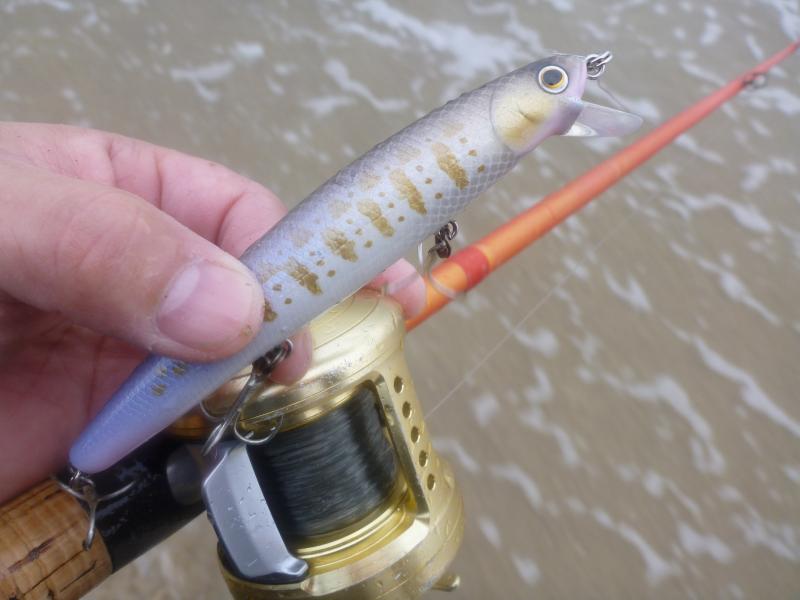 Carolina rigging consists of a sliding egg sinker, bead, swivel, 18”-36” fluorocarbon leader and a hook. In small surf a ½ ounce egg sinker works well. In bigger surf or when fishing in the wind use a ½ – 1-ounce or sinker to keep your bait on the bottom.
Carolina rigging consists of a sliding egg sinker, bead, swivel, 18”-36” fluorocarbon leader and a hook. In small surf a ½ ounce egg sinker works well. In bigger surf or when fishing in the wind use a ½ – 1-ounce or sinker to keep your bait on the bottom.
The second setup I use when fishing with lures is either a straight connection of the lure to my mono or using a uni to uni knot to connect my main line to 10lb fluorocarbon leader and then tying on my lure.
Fluorocarbon leader is a good idea whenever I’m fishing near rocks or over structure. Fluorocarbon allows me to use a heavier leader and it’s much more abrasion resistant than monofilament.
Without question hard baits are one of the most productive surf lures. I use the Lucky Craft FM 110, Rapalla SXR-10 XRAP and Infinity jointed lures. These lures are best cast out and retrieved with a stop and go motion. They should be tied straight to your main line or onto a short uni to uni connected fluorocarbon leader. Most halibut move slowly so a fast retrieve may pass the fish by. A fish attractant applied to your lures will also help to attract fish and make them hold on once they bite.
To fish hard baits effectively try this: Cast your bait out in a fan motion to cover as much surface area as possible. Once you cast out reel up all your slack and pull your rod hard to the side (in a snagging motion). This will drive the bait down to the strike zone. Vary your retrieve with slow, fast and a stop start motion. Be sure to slow your retrieve way down once you are about half way in so the lure does not come in contact with the bottom. Once you get a bite reel down to set the hook.
When it comes to spoons the two most effective for the surf have always been Luhr-Jensen’s silver Krocodile and the Acme Kastmaster. These lures are easy to use and should be tied directly to your line. A good size to use is one between 5/8oz and 1oz.
A long fan casting pattern and a slow retrieve, with the lure bouncing across the bottom, seems the most effective presentation. Fishing spoon lures at peak low tide will allow you to cast outside the surf line to offshore structure and holes. Or, fish these lures at high tide and you can concentrate on the inshore trough where halibut hunt for food.
Grubs and plastic lures also work great in both the open beach and near rocks for halibut. Two styles of plastics seem to work best in the surf.
The first, known as a grub, is in the shape of a pollywog. Most grubs in the 1 ½” to 3” range seem to work best. Attach grubs to you line using the Carolina Rig. Look for colors that imitate what the halibut are eating. Common colors are motor oil, white, smelt and grunion patterns.
Unlike grubs, plastic swim baits can be tied directly to your mainline. Use a leadhead that matches the size of your bait and the current you will be fishing in. Once again remember to keep your bait in contact with the bottom and don’t be shy from dunking your plastics in “hot sauce” to attract and catch more fish.
The best colors for finding halibut have been the colors that reflect what the fish have been eating: Sardine, anchovy, smelt, grunion and squid.
Drop shot and twitch baits are made of the same material as plastic baits but require different rigging. These baits are a true crossover from fresh water bass fishing and have become very effective when used in the surf for halibut. Look in your local tackle shop for Basstrix and Sluggo products.
Rig the twitch bait with either a small 1/8th leadhead (or the new Mustad “Power Lock” weighted hook) and tie it directly to your line. You may also rig it using the drop shot method.
The drop shot rig is simply a sinker on the very bottom of your line and a loop 12” – 24” up your line for the hook and bait. When using the drop shot rig, don’t tie the lure directly to your loop. Run the line through the hook’s eye and allow the lure to slide freely on the loop in your line. This will give the bait a much more natural look and help you to entice more fish to bite.
Twitch baits work best when they are cast out and retrieved slowly using stop and go then twitch motion. When using the drop shot rig try to find the lightest sinker you can use and still stay on the bottom. This will help to reduce the number of snags and tangles in the rocks. Look for lure colors that reflect what the fish are eating and fell free to use the “hot sauce” on these baits too.
There are many types of live bait locally available for use when targeting halibut in the surf. Live, fresh dead or unfrozen sardine, anchovy, smelt and grunion all work well in the surf. Additionally, strip mussel lip, threaded on the hook like a worm, is natural bait for halibut and also seems to work well when the bite is tough.
Use either a spinning or conventional outfit and the Carolina Rig. I like to hook my baits (anchovy, sardine, smelt, grunion) through the bottom and top lip with my hook to be sure they swim correctly and give the most natural presentation. Fishing with natural baits requires a much slower retrieval and periods of stop and start that allow the lazy halibut to catch up with their next meal.
Both anchovy and sardines can be purchased at your local tackle shop or at a quality fish market. Smelt and grunion can be caught by anglers and kept alive or fresh dead for bait. You’ll find smelt near docks, inlets and inside local harbors. They can be caught with a bait catching rig or a dip-net using breadcrumbs.
Grunion can only be caught by hand during a grunion run at your local beach—but be careful, as there are specific times they are not allowed to be collected. To learn more about grunion runs and rules check here with the DFW: https://www.wildlife.ca.gov/Fishing/Ocean/Grunion
Bill Varney’s passion for surf fishing is detailed in his how-to book: Surf Fishing, The Light-Line Revolution available at most tackle shops and on line @ www.fishthesurf.com. Check out Bill’s upcoming on-the-beach surf fishing clinics under the “Seminar” tab on his site.

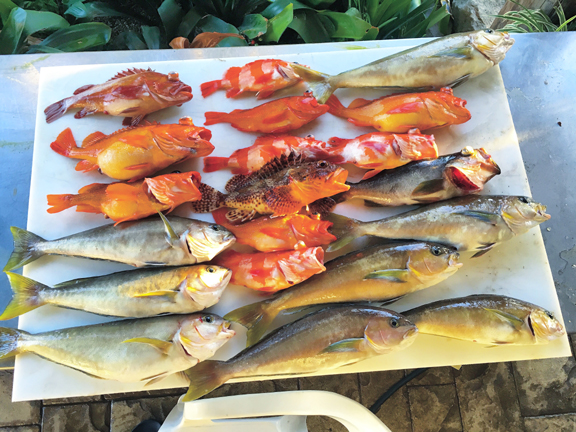
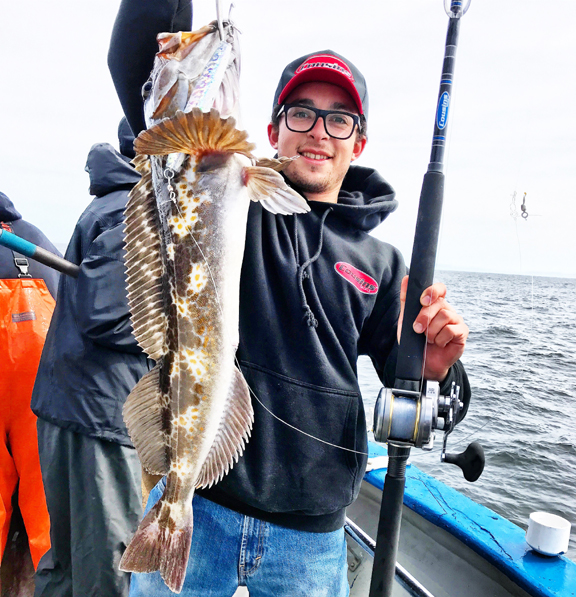 With all the species that we have in California, the options are phenomenal. Not only is there an array of different fish to target, there are so many ways to target each fish. One of the staples in our West Coast fishing world, from south of the border all the way up to Oregon is bottom fishing. From rockfish to ling cod, to everything in between, it’s a great way to get beginners and kids hooked on fishing, and it is still quite enjoyable for the avid fisherman.
With all the species that we have in California, the options are phenomenal. Not only is there an array of different fish to target, there are so many ways to target each fish. One of the staples in our West Coast fishing world, from south of the border all the way up to Oregon is bottom fishing. From rockfish to ling cod, to everything in between, it’s a great way to get beginners and kids hooked on fishing, and it is still quite enjoyable for the avid fisherman.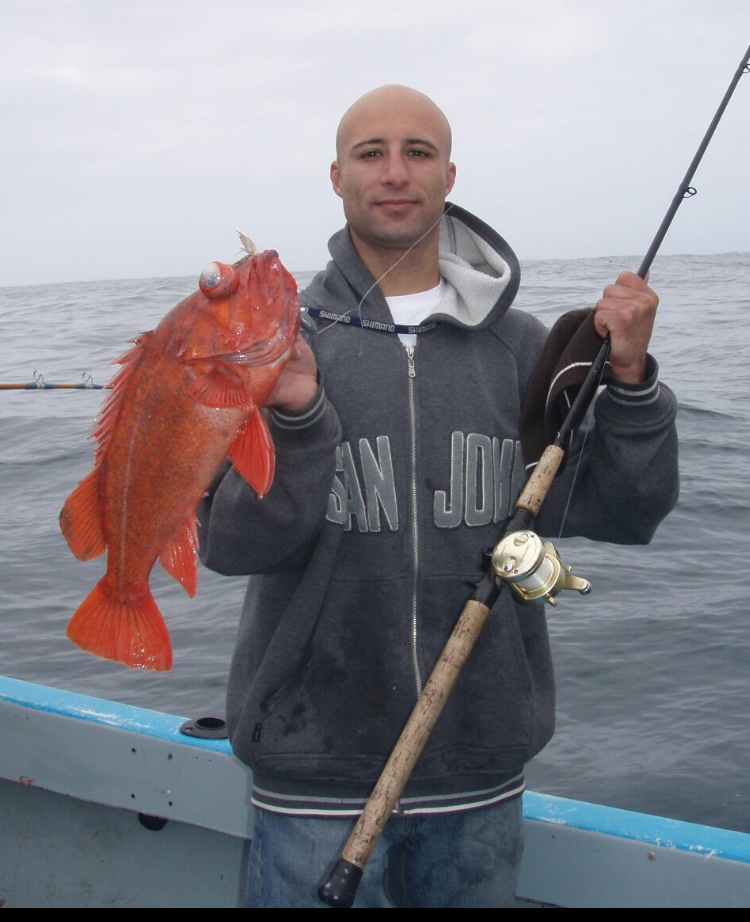 The majority of the bottom fishing that I’ve personally done, has been in San Diego and south of the border. However, this last year or so, I’ve put in a good amount of time in Northern California, primarily off coast of San Francisco. Regardless of where you are on the coast, there are many crossovers in the techniques of targeting these bottom dwellers.
The majority of the bottom fishing that I’ve personally done, has been in San Diego and south of the border. However, this last year or so, I’ve put in a good amount of time in Northern California, primarily off coast of San Francisco. Regardless of where you are on the coast, there are many crossovers in the techniques of targeting these bottom dwellers.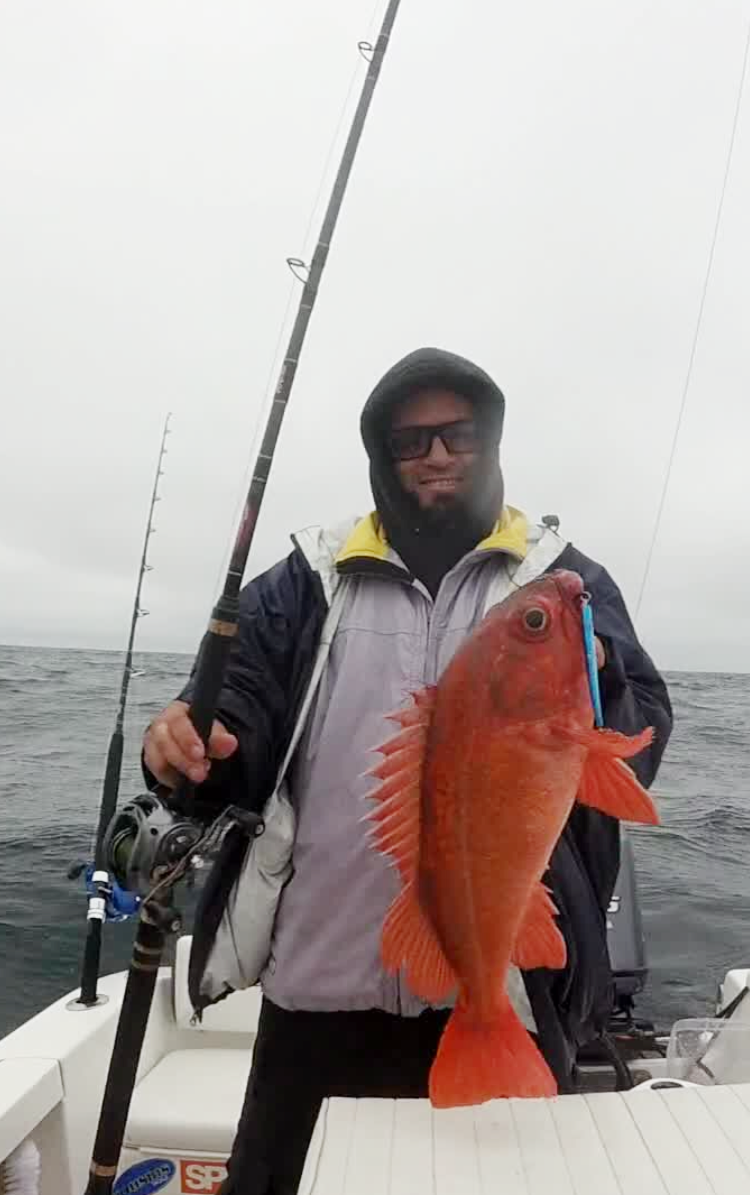 My preferred way to target the larger models is either with a heavy jig or a heavy bucktail. Depth and current will dictate how heavy of a lure you will use. When fishing at a depth of 200 feet-300 feet, a 2 ounce or 3 ounce lure just won’t cut it. In this situation, you need to go to a 10 ounce to 14 oz jig. There are numerous options out there for this but my preference is from SPRO which makes a great bait called the Prime Bucktail Jig. It comes in a variety of sizes and colors, up to 8oz. They also make a Squid Tail Jig, that is a deadly bait for shallow water bottom fishing, also offered in a handful of colors, up to 3oz. Both the Bucktail and the Squid Tail come in glow in the dark colors, which can be killer and set your apart from the next. Additionally, P-Line makes a great Chrome Jig, as seen in the photo below. It’s perfect for getting to the bottom as fast as possible, even in deep and rough seas. These range from 8oz to 16oz.
My preferred way to target the larger models is either with a heavy jig or a heavy bucktail. Depth and current will dictate how heavy of a lure you will use. When fishing at a depth of 200 feet-300 feet, a 2 ounce or 3 ounce lure just won’t cut it. In this situation, you need to go to a 10 ounce to 14 oz jig. There are numerous options out there for this but my preference is from SPRO which makes a great bait called the Prime Bucktail Jig. It comes in a variety of sizes and colors, up to 8oz. They also make a Squid Tail Jig, that is a deadly bait for shallow water bottom fishing, also offered in a handful of colors, up to 3oz. Both the Bucktail and the Squid Tail come in glow in the dark colors, which can be killer and set your apart from the next. Additionally, P-Line makes a great Chrome Jig, as seen in the photo below. It’s perfect for getting to the bottom as fast as possible, even in deep and rough seas. These range from 8oz to 16oz.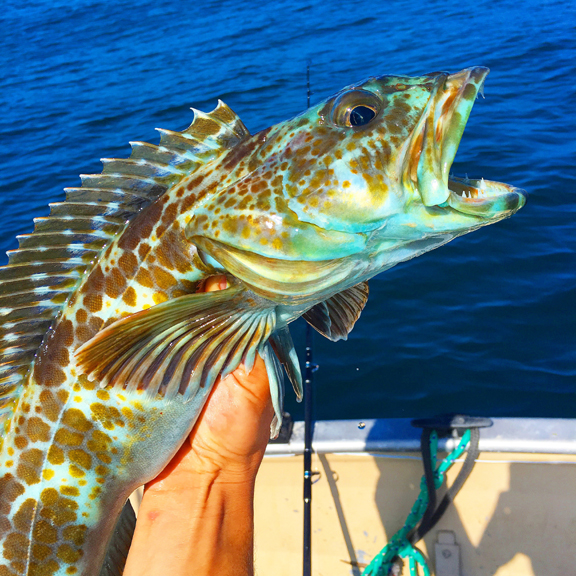 Another method, one that will typically out-fish the former in terms of quantity and numbers, is a dropper loop with two hooks. In Northern California, they will typically fish two shrimp flies, and tip them with strips of squid, whereas down south, we often fish bare hooks with strips of squid. Both methods will work in either location.
Another method, one that will typically out-fish the former in terms of quantity and numbers, is a dropper loop with two hooks. In Northern California, they will typically fish two shrimp flies, and tip them with strips of squid, whereas down south, we often fish bare hooks with strips of squid. Both methods will work in either location.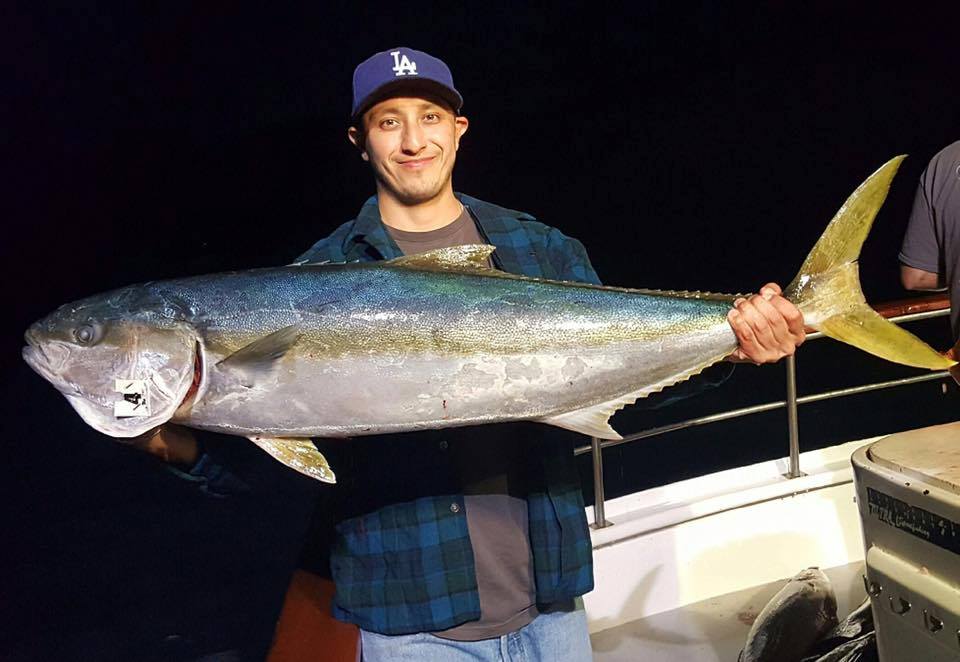
 Your reel is screaming as your line is peeling off it at a rapid pace. The fish takes a turn to the left and you must follow it. At that point, the real challenge occurs. There are nine other anglers to your left with their lines straight out. What do you do?? Well first off welcome to catching yellowtail on a party boat. Second, you head that way going over or under the other angler’s lines and rods as you chase your fish. This action has many names like the Chinese fire drill, Texas Two Step Shuffle or it sometimes is called something that I can’t print on these pages.
Your reel is screaming as your line is peeling off it at a rapid pace. The fish takes a turn to the left and you must follow it. At that point, the real challenge occurs. There are nine other anglers to your left with their lines straight out. What do you do?? Well first off welcome to catching yellowtail on a party boat. Second, you head that way going over or under the other angler’s lines and rods as you chase your fish. This action has many names like the Chinese fire drill, Texas Two Step Shuffle or it sometimes is called something that I can’t print on these pages.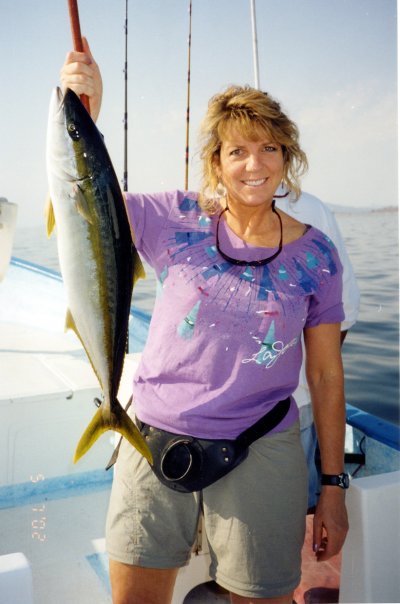 Southern California yellowtail fishing usually begins sometime in March-though this year in San Diego it was earlier and continues to November. Our local landings sportfishing trips can all catch yellowtail from ½ day trips to overnight and longer trips. Typically, the longer trips have more consistent catches and in greater numbers, but this is not always the case.
Southern California yellowtail fishing usually begins sometime in March-though this year in San Diego it was earlier and continues to November. Our local landings sportfishing trips can all catch yellowtail from ½ day trips to overnight and longer trips. Typically, the longer trips have more consistent catches and in greater numbers, but this is not always the case. Local yellowtail fishing can be at one of our local islands which is either San Clemente Island or Catalina Island and occasionally Santa Barbara Island. Or it may be paddy hopping. It just depends on where the fish are. Either overnight or ¾ day trips are the best trip lengths to catch spring yellowtail. During warmer water years yellowtail will bite fin baits such as sardines, anchovies, and even mackerel. During normal to colder water spring periods live squid may be needed to get the yellowtail in the biting mood. Yo yoing an iron jig can also be effective as well as sight casting to breezing schools of yellowtail on the surface.
Local yellowtail fishing can be at one of our local islands which is either San Clemente Island or Catalina Island and occasionally Santa Barbara Island. Or it may be paddy hopping. It just depends on where the fish are. Either overnight or ¾ day trips are the best trip lengths to catch spring yellowtail. During warmer water years yellowtail will bite fin baits such as sardines, anchovies, and even mackerel. During normal to colder water spring periods live squid may be needed to get the yellowtail in the biting mood. Yo yoing an iron jig can also be effective as well as sight casting to breezing schools of yellowtail on the surface.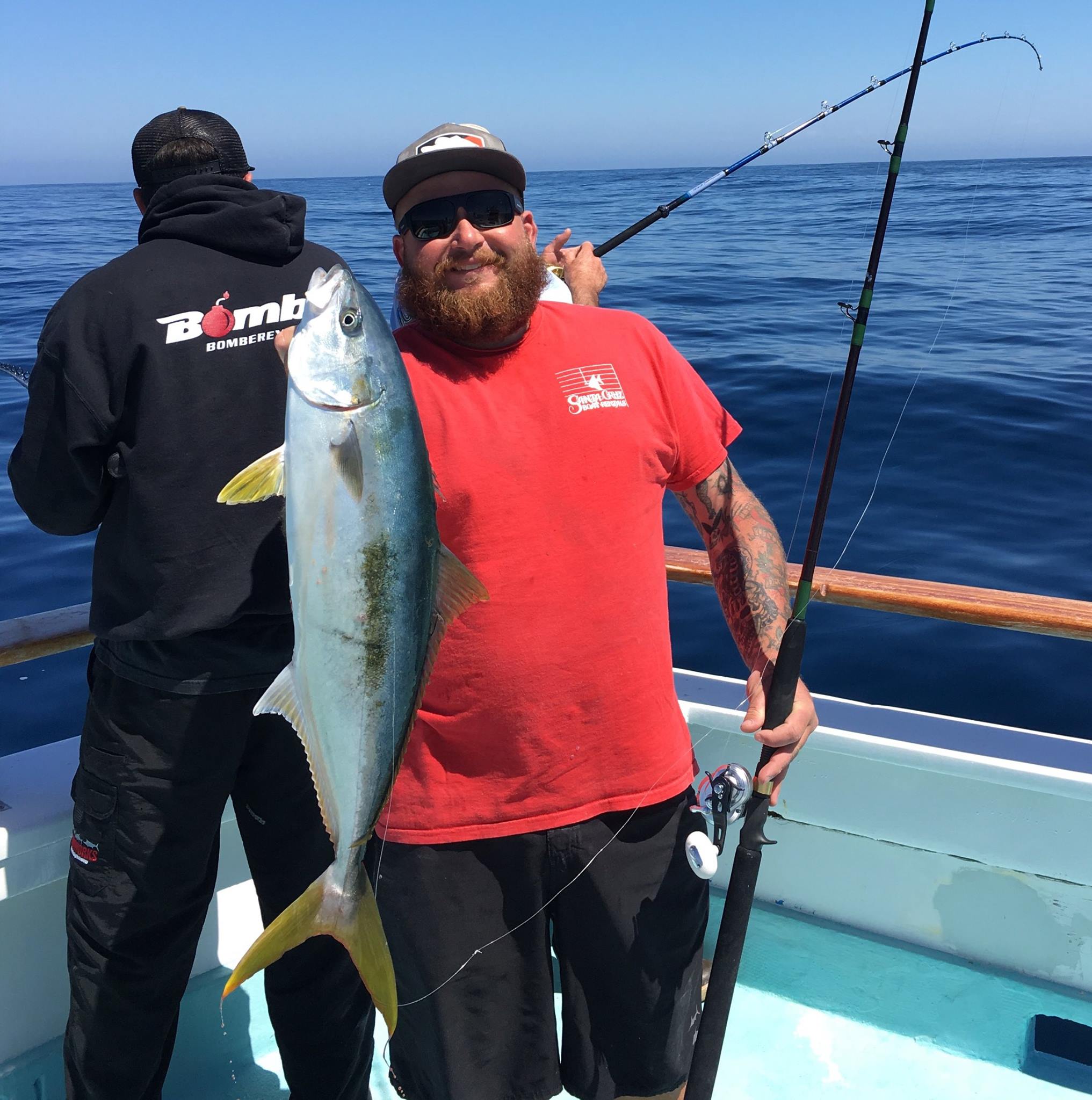 Once you have cast your fin bait try to let it swim as natural as possible this means letting it take line out and not pulling on it or creating resistance against the bait. If your bait is staying put and not moving much you can give it a twitch to wake it up. If that doesn’t liven your bait, then it is time to change your bait. Change your bait at least every other cast. This is very important as strong bait will get the most bites of yellowtail and almost all other game fish. The only time this doesn’t apply if you have limited bait or a limited type of bait in which case try to make the most of each bait. The deckhands will let you know if that is the situation.
Once you have cast your fin bait try to let it swim as natural as possible this means letting it take line out and not pulling on it or creating resistance against the bait. If your bait is staying put and not moving much you can give it a twitch to wake it up. If that doesn’t liven your bait, then it is time to change your bait. Change your bait at least every other cast. This is very important as strong bait will get the most bites of yellowtail and almost all other game fish. The only time this doesn’t apply if you have limited bait or a limited type of bait in which case try to make the most of each bait. The deckhands will let you know if that is the situation.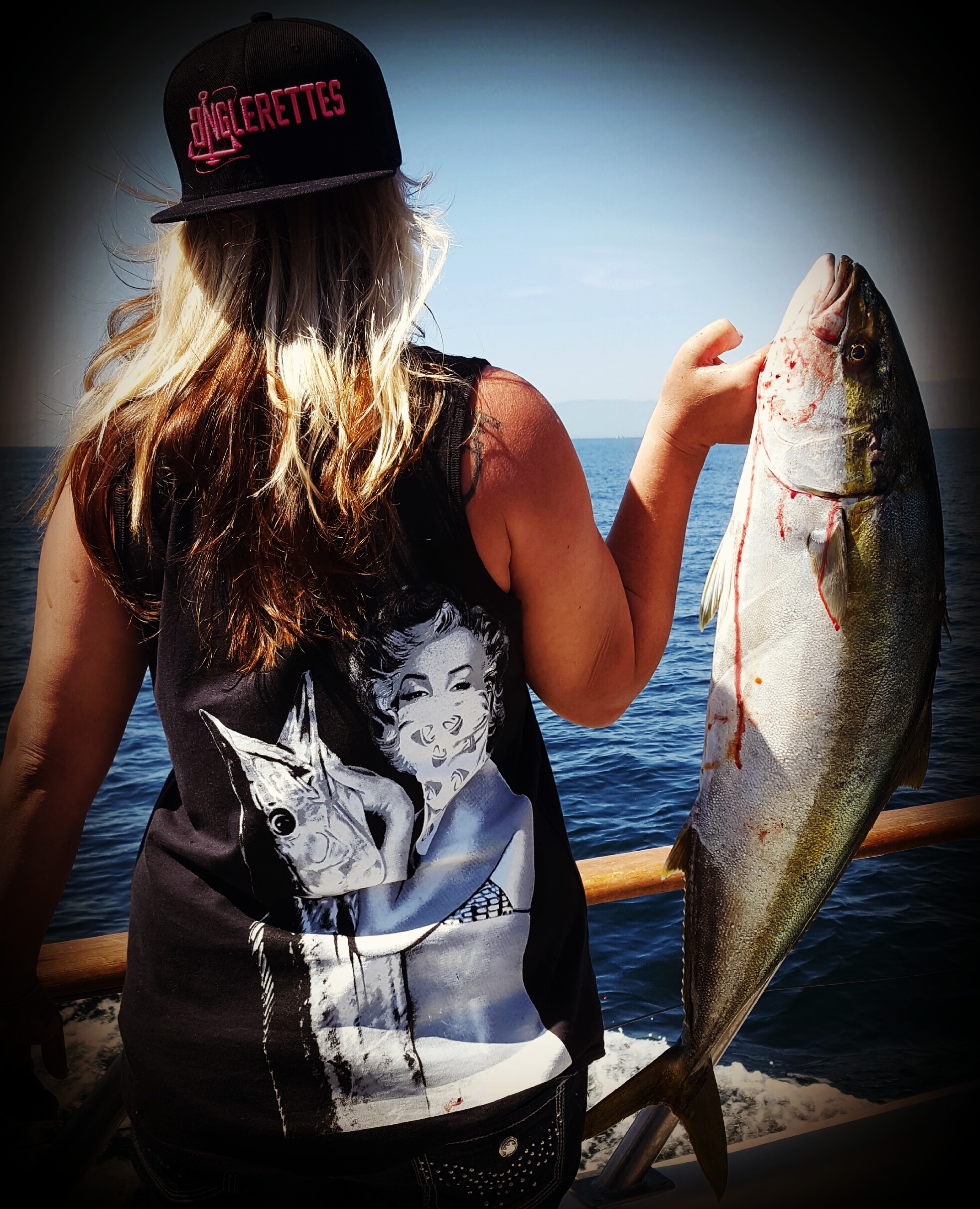 When fishing live squid techniques change quite a bit. First you can use a live squid for many casts as a yellowtail will be just as likely to hit an almost dead squid as a lively one. In fact there are times when fresh dead squid is preferred to live squid. There are not too many different ways to hook a squid as you want to hook it in the upper cone area away from the head. Ideally hooking it and then bring the hook back again so it is securely attached. Lots of smaller fish will pick at your bait and if it is not securely attached it will be taken off the hook very quickly by the smaller fish. A large hook such as 2/0 -4/0 (Owner and Mustad are good brands) is ideal as yellowtail will not be hook shy like they can be with fin bait. When fishing with live squid be prepared to fish both deep and shallow or close to the surface. Sometimes the bite is right on the bottom and other times it will be in the middle of the water column or on the surface. Keeping an eye on where anglers are getting bit is the key to using the right weight for the given situation. Your live squid should not run too much even if fishing without any weight so if it starts really moving it is a fish.
When fishing live squid techniques change quite a bit. First you can use a live squid for many casts as a yellowtail will be just as likely to hit an almost dead squid as a lively one. In fact there are times when fresh dead squid is preferred to live squid. There are not too many different ways to hook a squid as you want to hook it in the upper cone area away from the head. Ideally hooking it and then bring the hook back again so it is securely attached. Lots of smaller fish will pick at your bait and if it is not securely attached it will be taken off the hook very quickly by the smaller fish. A large hook such as 2/0 -4/0 (Owner and Mustad are good brands) is ideal as yellowtail will not be hook shy like they can be with fin bait. When fishing with live squid be prepared to fish both deep and shallow or close to the surface. Sometimes the bite is right on the bottom and other times it will be in the middle of the water column or on the surface. Keeping an eye on where anglers are getting bit is the key to using the right weight for the given situation. Your live squid should not run too much even if fishing without any weight so if it starts really moving it is a fish.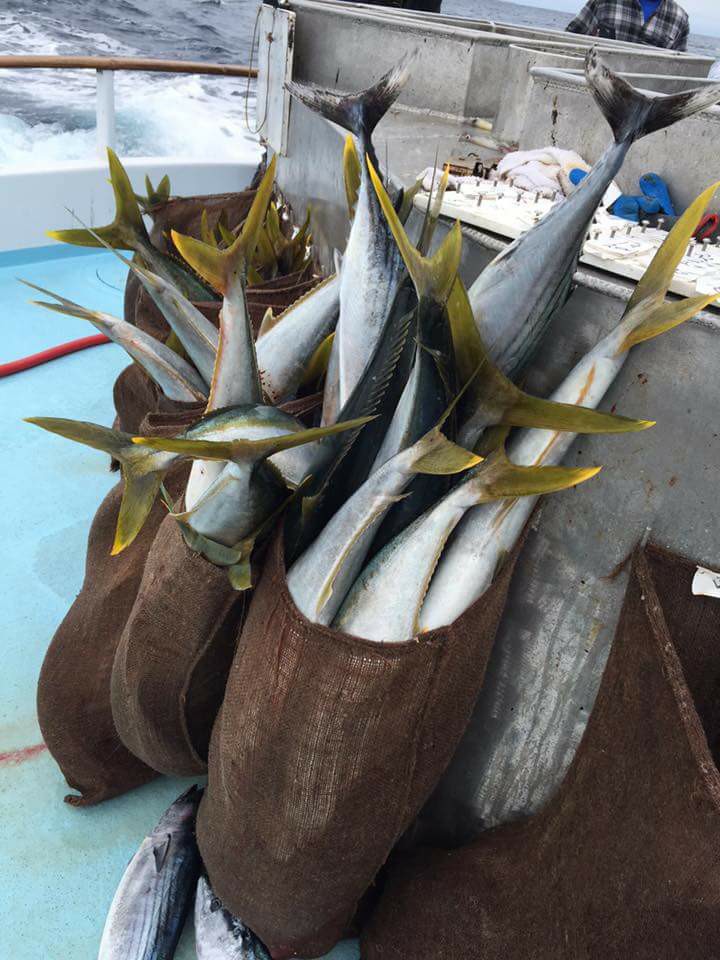 Fishing iron jigs that run deep, medium weighted, and even surface iron can be very effective. One must be very careful though when doing this type of fishing. It just takes one second of not being aware to hook someone in the head. Some boats actually discourage people throwing jigs when the boat is crowded. Safety first. After making sure the coast is clear, cast your jig a good distance from the boat and then letting it sink for varying times allows you to cover different depths and with different angles of retrieves creating different presentations. The key when fishing a jig is to keep it moving. Usually the faster the better. Surface iron maybe the exception as there is times when a slower presentation works. When using an iron jig you can fish along the side and even in the front of the boat and cover a lot more area than by bait fishing. Most of your bites will come while reeling it back and you need just keep reeling as you get bit. The reeling tension and the fish should set the hook. Make sure your hooks are super sharp before you start fishing. When yellowtail are breezing on the surface a surface iron can be really effective and you can cast into the school before they are disturbed by the boat.
Fishing iron jigs that run deep, medium weighted, and even surface iron can be very effective. One must be very careful though when doing this type of fishing. It just takes one second of not being aware to hook someone in the head. Some boats actually discourage people throwing jigs when the boat is crowded. Safety first. After making sure the coast is clear, cast your jig a good distance from the boat and then letting it sink for varying times allows you to cover different depths and with different angles of retrieves creating different presentations. The key when fishing a jig is to keep it moving. Usually the faster the better. Surface iron maybe the exception as there is times when a slower presentation works. When using an iron jig you can fish along the side and even in the front of the boat and cover a lot more area than by bait fishing. Most of your bites will come while reeling it back and you need just keep reeling as you get bit. The reeling tension and the fish should set the hook. Make sure your hooks are super sharp before you start fishing. When yellowtail are breezing on the surface a surface iron can be really effective and you can cast into the school before they are disturbed by the boat.